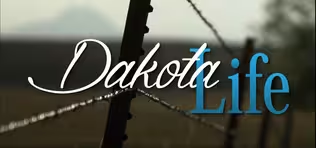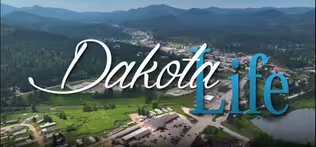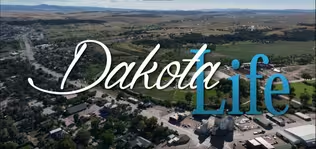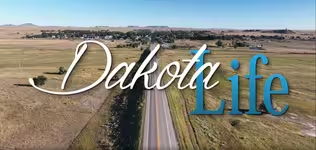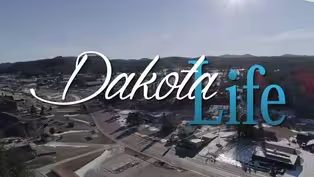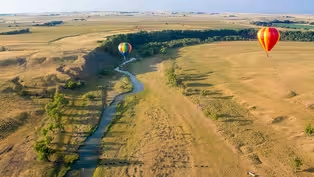Dakota Life
Greetings from Box Elder
Season 27 Episode 3 | 28m 52sVideo has Closed Captions
The community of Box Elder is one of the fastest-growing cities in South Dakota.
We visited the Air and Space Museum, toured Ellsworth Air Force Base, participated in Patriot Days, Box Elder's foremost celebration, and learned how Box Elder plans to grow its community in the future.
Problems playing video? | Closed Captioning Feedback
Problems playing video? | Closed Captioning Feedback
Dakota Life is a local public television program presented by SDPB
Support Dakota Life with a gift to the Friends of Public Broadcasting
Dakota Life
Greetings from Box Elder
Season 27 Episode 3 | 28m 52sVideo has Closed Captions
We visited the Air and Space Museum, toured Ellsworth Air Force Base, participated in Patriot Days, Box Elder's foremost celebration, and learned how Box Elder plans to grow its community in the future.
Problems playing video? | Closed Captioning Feedback
How to Watch Dakota Life
Dakota Life is available to stream on pbs.org and the free PBS App, available on iPhone, Apple TV, Android TV, Android smartphones, Amazon Fire TV, Amazon Fire Tablet, Roku, Samsung Smart TV, and Vizio.
Providing Support for PBS.org
Learn Moreabout PBS online sponsorshipMore from This Collection
Dakota Life stories from towns in western South Dakota
Video has Closed Captions
Greetings from the ranching community of Union Center. (27m 53s)
Video has Closed Captions
Visit an artist coop, the state railroad museum, gardening enthusiasts, and an annual film (25m 49s)
Video has Closed Captions
Dakota Life visits Custer and the surrounding area. (24m 56s)
Dakota Life: Postcard from Hot Springs
Video has Closed Captions
Dakota Life: Postcard from Hot Springs (29m 49s)
Providing Support for PBS.org
Learn Moreabout PBS online sponsorship- This is a production of SDPB.
- I feel like we found a really awesome community and I think everyone in the community is so supportive and everybody's always blown away.
You know, when I tell 'em, both my husband and I fly B ones and they're always very thankful and appreciative.
- What I love is that I stayed in one place.
I met my husband here and had raised my kids here with the help of all those people.
- Handoff goes number 22, made in sandal.
- Join our crew as we meet the people who are growing, celebrating, and building box elder.
- Greetings from box elder.
- Greetings - From box elder.
Greetings from box elder.
Greetings from Ellsworth Air Force Base.
- Greetings from Ellsworth Air Force Base.
- Greetings from Ellsworth Air Force Base.
- Greetings from Ellsworth Air Force Base.
Greetings - From Ellsworth Air Force Base.
- Dakota Life is supported with your membership and with help from West River Electric Association is owned by their members.
Together with their partners, they're keeping all corners of South Dakota vibrant, allowing their member owners to use energy to own their day.
And by Black Hills Federal Credit Union.
Since 1941, black Hills Federal Credit Union has offered financial solutions that empower their members to reach their goals.
B-H-F-C-U is pleased to contribute to the development of the box elder community immunity - Donors to the Explore South Dakota Fund support the production of local documentaries and other programs of local interest presented by SDPB.
Friends of SDPB appreciates their support of this program.
- Woo, that was a bumpy ride.
Hello everybody.
Welcome to Dakota Life.
Today we're in the town of Box Elder and I'm on a mission to discover what makes this community so special.
Today is a very special day for box elder.
It's the grand reopening of the South Dakota Air and Space Museum back bigger and better than ever.
The extensive collection here makes Ellsworth Air Force base, one of the most important places in US aviation history.
Sdbs Jackson, Thorson takes us there.
Now, - The B one, right when you come in the gate is you don't get how big some of these planes are until you get out and walk around him.
- Just outside of Ellsworth Air Force Base's main gate, the South Dakota Air and Space Museum has been a prime tourist destination since 1983.
The museum has been closed since the start of the COVID-19 pandemic, but this summer it was once again open for service, - Having the renovations done and they will be ongoing.
Readjustments will be made.
The whole part of this is to open it back up to the public and do things that will draw people in, but it's baby steps.
It needs to happen in certain ways and we're in the beginning stages of kind of getting it all ramped up again the way it should have been - And those beginning stages are already paying off.
Listen to Jackson and his grandpa on a trip from Minnesota.
- It seems really cool and I'm pretty excited to go inside and look around - Or this family from Switzerland inside the museum, four galleries within four aircraft hangers that housed thousands of artifacts.
- These hangers were on base, they didn't need 'em anymore, and somebody had the bright idea to, Hey, let's do this.
So the, the hangers were moved here and the planes started coming in and then the exhibit started and here we are - Around the Air Park.
You'll find 30 aircraft from President Eisenhower's personal plane to the iconic Huey Helicopters.
- If you've ever seen any film about Vietnam and seen a helicopter, you've probably seen a Huey for medical emergencies and for security emergencies and so forth.
We had a squadron of Huey helicopters here in their crews.
And those helicopters would be used for high priority transport out to the missile field.
- Although Kim enjoys teaching others about all the aircraft in the park, there is one that he actually flew.
- The B 52 that sets on display is an aircraft that I flew out of air base in Thailand in 1974.
If a grandson comes to visit, instead of telling them I used to be a tail gunner on a B 52, I can bring him out here and I can point up to the back end of the aircraft and the guns are there and, and the canopy that I sat under is there.
And it just makes it a lot more meaningful, a lot easier for me to share my rather unusual experiences with family and and random people also.
I just want to know more.
- It's that history of tradition that kept Kim going when he was preparing to fly through enemy fire in 1972 - When I was trained to be a gunner on the B 50 twos.
A part of the training was history and, and in fact most of my instructors were World, world War II veterans.
So I kind of lived with history as I was being trained for this job.
As as I was questioning myself and whether I could perform in that situation or not, I had a a, a feeling and awareness that I knew that many of my instructors and tens of thousands of other people had flown dangerous, dangerous battles where a lot of aircraft were being shot down and people being lost and they kept going.
And that is what the Air Force had done up until 1972 and continues to do today.
We don't go out to and attack a target and decide that, oh, it's a little bit too scary.
We're not going to attack that target.
We go, you, you, you just go.
That's just what you do.
And having that knowledge, having that, that understanding that thousands, tens of thousands, hundreds of thousands maybe had done this before me and that I could do that, I was able to just put that fear in the compartment where I belonged and focused on doing what I knew I could do, what I knew others had done before me, you know, accomplish the, the mission that had been set.
So everything I said about the richness of learning and the richness of the story being enhanced by the availability of artifacts adds up to being able to do a better job to help the men and women in the Air Force today understand that you come from a long line of people who have a tradition of doing what needs to be done, when it needs to be done.
- The South Dakota Air and Space Museum, a place for veterans like Kim or anyone to step back in time - On my mission So far I've seen a lot of what box elder has to offer and one very important staple of this community is Patriot Day stand up.
It's a yearly celebration with vendors, food trucks and live music.
This all around party gets kicked off with an epic parade.
What ler - I?
- But first and foremost, it's a way to recognize current and former military members and their families because that's what's at the core of box elder patriotism and a love for one's country and community.
But before we learn more about box elder and its citizens, let's take a moment to speed through its history because I gotta tell you, I feel the need, the need for speed.
You'll find a whole lot of beauty in this corner of the state nestled between the black hills and the Badlands.
This place was known by the Lakota for its numerous trees that grew along the creek.
Many of those trees just so happened to be box elder maples, which in 1907 inspired the name for both the body of water and the town that grew up around it.
The city started out as a train stop for passengers to get out, stretch their legs and hop back aboard, continue their journey.
But in 1942, the town really took off.
Literally that's when the Rapid City Army Air Base came on the scene.
It was at the height of World War II and American bomber crews needed a place to train on the mighty B 17 Flying Fortress.
They found it just northeast of box elder.
The base was renamed Ellsworth Air Force Base in 1953 after a B 36 carrying 23 local airmen crashed in Newfoundland, one of whom was base Commander Brigadier General Richard Ellsworth, president Dwight d Eisenhower personally flew into town to rename the base in his honor.
Today Ellsworth is home to three out of the four squadrons that participated in the legendary Doolittle raid.
A pivotal moment that changed the trajectory of World War ii.
The Raiders of the 34th, 37th and 89th continue to carry on this legacy of aerial supremacy and global prowess.
The story of box elder is strongly tied to the base, but to many civilians, the part of the story that lies beyond the gates is a mystery.
We're about to take a tour of Ellsworth Air Force Base, but first we need to meet a friend.
Come on Crystal, how's it going?
- Great, how are you?
- I'm fantastic.
Happy to be here today.
I heard you have a little experience with the military.
- I do.
I spent 20 years in the Air Force as an air transportation specialist, which basically means I just loaded cargo and passengers on military aircraft, - Just cargo and passengers.
I'm sure you saw all sorts of things in that time.
- All the things.
- So you kind of know what's going on behind this gate, what's back there?
I've never been on this space before.
- So everybody is a little bit different depending on their mission and their location.
But most bases usually have everything they need to support and sustain the people who live and work there.
So things like post offices and childcare centers and even fun things like theaters and bowling alleys.
- No way.
Holy moly.
Well, should we go take a look and see what it's like?
- Yeah, let's - Go.
All right, let's go.
With the help of Air Force Public Affairs, our public broadcasting crew met with base leadership and saw that Ellsworth has all the amenities of a city, but the real privilege was meeting the people who make the mission possible.
Got it, thank you.
- Yeah, of course.
There are two jets that just landed, so it might be a little louder than normal.
- How long have you been a pilot for the B one?
- I have been a pilot in the B one for about two years now, but I have been a pilot for about six years.
So it took me about two years to start incomplete pilot training than I stayed as an instructor.
And then after about four years as an instructor, I was selected to fly the B one and now I'm here.
- I'm sure one of a few female pilots in a male dominated career field.
- I think the really part is to remember that to everybody that I work with, I'm just another pilot, right?
I don't really think that gender plays a role in that.
There are definitely things that are different, right?
Being a girl pilot.
But I think that to me and to the people that I work with, I'm just a pilot.
I grew up with an Air Force pilot father who flew with a bunch of women.
So I grew up seeing that and it's really nice to be able to kind of represent that and give that back and be that kind of face to you can be a girl and you can be a pilot as well.
We play a really critical role just because we have so many mission sets, we're able to do so much and I think because we have this really dynamic capability, the V one maintains this really big presence both here at Ellsworth and off station as well.
We are the premier strategic long range bomber.
We do have the biggest payload in the Air Force as well.
So we're able to carry the most weapons on A DOD perspective.
I think that we play a key role into early nights in potential conflicts.
The pilots are really interesting in that we have one person who we call the pilot flying who's in charge of just putting the aircraft where it needs to be, whether that's in certain parameters to release weapons or getting us to and from different destinations.
And then we have another person that is pilot not flying who's primarily responsible for pushing our mission forward, double checking weapon perimeters, making sure that everything is set correctly.
So we have two really dynamic positions, even just within the two pilots in the front station.
And then we have two zos, our weapons systems officers in the back station.
- So as a weapon system officer, we have one offensive, one defensive.
We're qual in both.
So for the offensive role, I'll be primary for maintaining navigation weapons, employment, as well as our sensors.
So our air day radar, air to ground, and then our targeting pod.
And for the DSO, we've got a very robust defensive avionic suite that we manage to keep ourselves safe from many threats.
Again, with a a crew of four, it takes all four aviators putting our brains together to solve the problem and work together.
So without two ZOS or two pilots, we wouldn't be able to make the mission happen.
If we get called upon, we can be anywhere, demonstrate global prowess and our strategic deterrent at a moment's notice and and just showcase the world class 28th bomb wing - In back shop.
We get flight line responses to come out here and fix things on the bomb modules or usual typical maintenances, just inspections on the bomb modules and making sure they're up and running so we can drop warheads on foreheads.
So I mean, without weapons we, we can't support anybody on the ground.
There's no bombs dropping without us.
So it's just another aircraft if you don't have weapons.
- I love your pride.
I love it - So much.
Didn't know I would like weapons until I got into it.
Being in direct contact with the mission really because you know, we we're the ones flight line side, loading the bombs, making sure they're dropping back shop side, making sure the bomb racks work the way they should so that we can drop the bombs.
- I love my job.
I love finishing a bomb.
At the end of the day when you finish it, you look at it and it's like 20 bombs in a row and it's like, yeah, might as well just scribble my John Hancock across the side of it.
I did that.
You know, we play a pretty critical role in ensuring the deterrence of other countries against us.
'cause what we don't want is to have a fight on our land.
We take the fight to the enemy every time We don't do that.
So with us building munitions and making sure they get to the jets, we're ensuring that people are safe.
We're ensuring that our people get home.
We're ensuring that like we, we, we tear buildings down at the same time.
Like we're making sure things don't happen to us.
We wanna save our people at the end of the day.
So our bigger mission is to deter at the end of the day, de turns, de turns, de turns.
So even if we flew this jet with bombs on you, we might not drop it, but the enemy seen it.
The enemy don't want that to blow up on top of them.
Are they gonna shoot it down?
Absolutely not.
- I've been in the military for just over 25 years.
I'm the age superintendent and that's the aerospace ground equipment.
So all this equipment that you see these guys running out here, that is what I am in charge of.
So like that is a nitrogen cart right there and the air conditioner they running over there.
That is what my guys maintain.
We have to maintain enough equipment to support both BGS and home station.
If the BGS have to leave wherever this aircraft goes, the equipment has to go.
So without this equipment, you can't service the aircraft, you can't do some of the objects, you can't fix a lot of things.
So, you know, being able to mobilize all this equipment and get it to the aircraft when it needs it is, is paramount because without this B one, the US couldn't do a lot of things that we do.
This is probably the most high demand asset in the Air Force inventory when it comes to STRATCOM requests.
We would love to be able to fill 'em all, but priorities are priorities, right?
So again, without the age it doesn't go.
So I try to stress that importance of my guys all the time that yes it, it's sometimes thinkless, but it's important because we need all this equipment to maintain this jet.
So from that position, I get to take care of people, right?
Like I said, without people, none of this happens.
It's just a bunch of paperweights.
And I think sometimes if you're not paying attention, it's easy to forget that that's a person behind everything that we do.
So if you don't put the people first, the mission doesn't happen.
- People would ask me, where's your main street?
And I'd have to say, oh, we don't have a main street.
- Boxelder is one of the fastest growing communities in South Dakota.
This bedroom town butts up against the northeast side of Rapid City, straddles the border of two counties, Pennington and Mead, with I 90 running through the middle, the main street in a divided city.
No problem.
- A developer came in there and he wanted to develop and he said, you know what are something we want to be partners with the city.
We want to do what you want.
What kind of things do you want?
And I said, A main street.
We want a main street.
And we had Liberty Boulevard coming in, which was undeveloped really along there, nothing on that 110 acres.
And so we had a blank slate.
And so that's what he did.
He put in a main street and so it comes right from Liberty Boulevard down to the Liberty Center there.
And that's been great 'cause now I can tell him where the Main Street is, - But it'll take a lot more than a main street to meet the growth happening in Boxelder Census data shows the town's population has more than quadrupled over the past 30 years.
From 2,700 in 1990 to nearly 12,000 in 2020.
And growth isn't letting up.
The latest population estimate surpasses 14,000 residents.
Add to that, the B 21 Raider coming to Ellsworth Air Force Base, bringing even more growth to the area.
Dane Bosma is a rancher and developer in the area.
He and his crews have about 200 lots under construction right now.
We caught up with him at the Freedom Landing Housing subdivision right outside of Ellsworth.
The growth doesn't phase him.
- I'm excited for the B 20 ones, but we have to take it in stride.
We have to take, if it's 50 that show up or 500, we have to take it in stride.
We're not gonna light the world on fire.
We're not gonna overbuild box elder.
We're gonna be smart about it.
We're gonna continue to put up good product.
We're gonna have nice subdivisions that are long lasting and, and, and really the B 20 ones has gotta fit into our culture and I think they will very well, but I'm not going to think it's the next greatest deal.
The next, you know, big, big thing.
We're just gonna take it in stride and, and we're gonna take care of people the way we always do.
- The mayor says Ellsworth's expected growth won't be a sudden influx of people all at once.
- It'll probably be about 200 personnel per year from the time they get here or a little before until 2043 approximately.
You know, as far as housing goes, we can probably handle that.
The base isn't building anything new, but we have enough different housing areas going up that we think we can handle it.
- But building a sense of community is one challenge in the divided city where most of its population stays for just a couple of years before transferring to another base.
- That's one of the reasons we started doing a lot of events in this particular, the Patriot Day.
We wanted to bring the community together because again, it was like a, you know, housing area over here and one way over here and nobody ever got together.
So bring 'em together, get 'em with the Air Force base all their people and try to develop that community feeling.
And so that's what we're working on.
We're continue to work on it.
It's certainly not done, but, but that's, that is one of the things that we want to work on.
- Patriot Day is one major event in Boxelder that honors their large community of active duty veterans and their families.
But it's not the sole event in the works.
- We've got Harry Cow coming, that'll make us a destination.
We've got the Air and Space Museum way underrated.
People need to go there.
It's amazing.
That makes us a destination.
We're working on the Black Hills Children's Museum right over by the Liberty Center and we've got the box event center.
It's part of the hotels there.
And that has been fantastic.
A lot of people don't realize that that's inbox seller.
It's called the Box.
And so yeah, that is going gung-ho.
They're give, bringing lots of events in there when they stay in the hotels.
And then there's the matter of the structurally - Divided city.
Here's booms, ma, - Box Elder, just with the terrain, the geography I 90 splitting, although that's created as challenges.
Box elder staff and city council.
They're, they're, they're doing great things to help merge the divided city.
You know, bike paths and park plans and things like that so that we're not so divided by the interstate.
Rather use that interstate as our strength.
Use that correct traffic count to pull people into box Elder.
Me personally, I would love to see those things.
I would love to start over here at the northeast side of box Elder and be able to walk, run, bike to the Southwest corner where Northern Lights is at, where I'm currently buildings.
- That includes infrastructure two, replacing antiquated water and sewer systems.
Larson says it's a lot of work keeping up with and getting ahead of the growth.
- We're working hard now to get grants and also just pay ourselves for sidewalks so we can connect everything to the schools to one another so that this housing area, if they wanna ride a bike or walk over to this housing area, they can get there.
And then not only that to a big master park that we're planning down on the other side of the railroad tracks, and that's probably 30 plus acres.
We'll have Green Greenway area and, and basically where we can move all of the things that we, our events down there and it'll be big enough for it.
- Whether it's building community and connection through infrastructure or community events.
The sky is the limit.
- Well, I flew into Box Elder to find out what makes it so special.
And I'd say my mission here is complete service is woven into this town's history, culture, and very existence.
And that feels particularly special to have right here in South Dakota.
Patriotism and pride are the heartbeat of Fox Elder.
We see this in the reopened Air and Space Museum, the coalescence on and off base.
And because of moments like this for everybody at SDPV, thank you for watching Dakota Life.
I'm Tim Davison.
Over and out.
Support for PBS provided by:
Dakota Life is a local public television program presented by SDPB
Support Dakota Life with a gift to the Friends of Public Broadcasting
